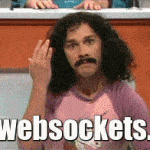This post was most recently updated on June 23rd, 2022.
2 min read.So a while back I posted about testing your “vanilla” WebSockets connection directly in the browser – and while that’s nice and easy, sometimes you need to class up a bit. In my case that meant upgrading to SignalR (for some corporate and enterprisey reasons as usual). It makes sense to leave behind the easy, simple, lightweight and somewhat transparent WebSockets to “upgrade” to the enterprise-ready (and arguably quite a lot less transparent) SignalR?
Well – I went through that, and since I needed to test the connectivity after the change, I documented here how you can do it in the browser!
Problem
You could always fire up an actual website to test your SignalR connection, or perhaps add some test code and deploy it to whatever environment your stuff is supposed to run in – or perhaps even create a new tester console application!
But why would you want to do that, since you can just run a couple of simple commands in your favorite browser’s console? No extra CORS -configuration is needed and you have full control over your code.
Solution
Now, what if you then need to test your SignalR-connection directly in the browser? Well, luckily, that’s pretty simple as well!
Time needed: 10 minutes
How to test a SignalR-connection in the browser?
- Include a SignalR client library in the browser
In our case, the front-end was packaged in a way it doesn’t expose the dependencies to the browser – so instead of using whatever library it was using, it was simplest to just include an external one by running this in the browser:
var sc = document.createElement("script");
sc.setAttribute("src", "https://cdnjs.cloudflare.com/ajax/libs/microsoft-signalr/3.1.7/signalr.min.js");
sc.setAttribute("type", "text/javascript");
document.head.appendChild(sc);
Obviously, you can use another version of the SignalR library – this is just the one I used. - (OPTIONAL) Retrieve access token
Only do this if your SignalR methods are protected with [Authorize] because unlike with vanilla WebSockets, SignalR kind of supports authentication & authorization.
- Build the SignalR hub connection
This should look somewhat like the below, in case you’re using authentication:
var connection = new signalR.HubConnectionBuilder().withUrl("https://localhost:44358/hubs/myhub", {
skipNegotiation: true,
transport: signalR.HttpTransportType.WebSockets,
accessTokenFactory: () => [access token from your earlier step]"
})
.build();
Note: skipNegotation is cool because it will skip all the extra HTTP -stuff before just plain and simple opening the connection. If you’re pretty sure the host exists and is trustworthy, go ahead and set it to true.
And if you haven’t protected your SignalR methods with [Authorize], don’t even add the accessTokenFactory. You should be good without it. - Hook your methods up to events (or the other way around)
At its simplest, this will look somewhat like the below:
connection.on("MyMethodName", function (e) { console.log({e}); }); - Initialize the connection
Ah, pretty simple – run this, and your front-end connection is listening to new messages!
connection.start();
And you should be good!
Note, that you need to target MyMethodName on the server-side in order for it to be picked up by the front-end.
References
- jwt.ms is convenient for verifying your access tokens.
- As an alternative option, you can use something like this website for testing and debugging your SignalR-setup – but you’ll need to add CORS origins for the site:
- https://gourav-d.github.io/SignalR-Web-Client/dist/
- And the associated GitHub repo: https://github.com/gourav-d/SignalR-Web-Client
- How to test a web socket connection in a browser
- Join my session at CTTT25 this week: Level Up Your Teams Extensibility Game with Blazor | Session materials from Cloud Technology Townhall Tallinn 2025! - January 28, 2025
- How to identify which wifi band your Decos are using? - January 21, 2025
- Don’t assign root domain to GitHub Pages if you use it for email! - January 14, 2025



